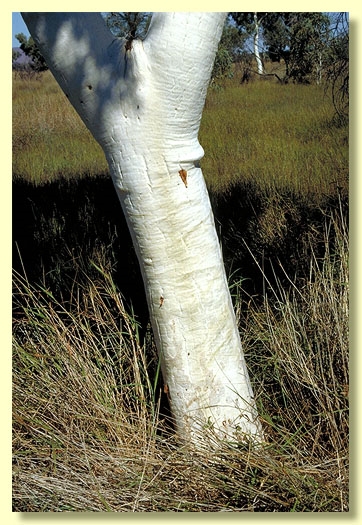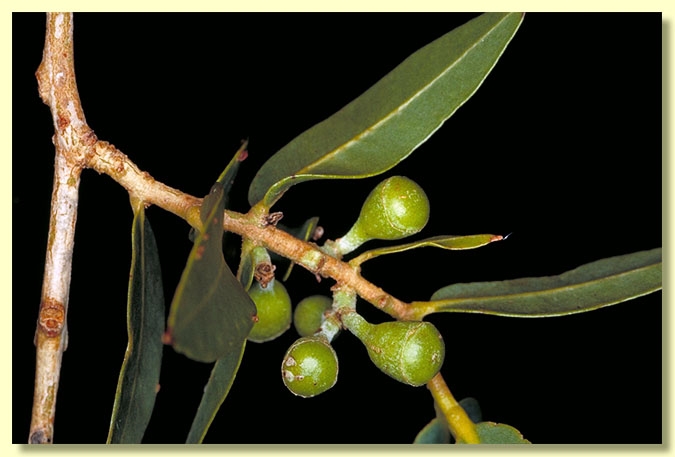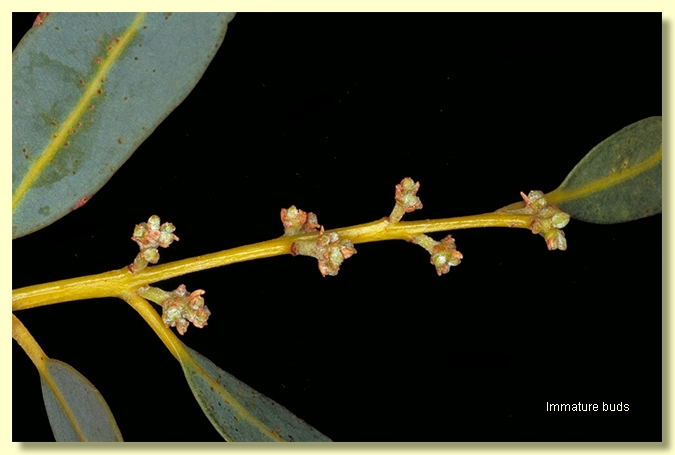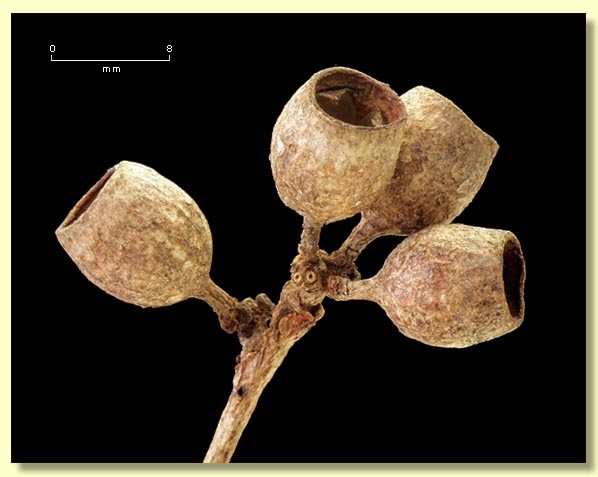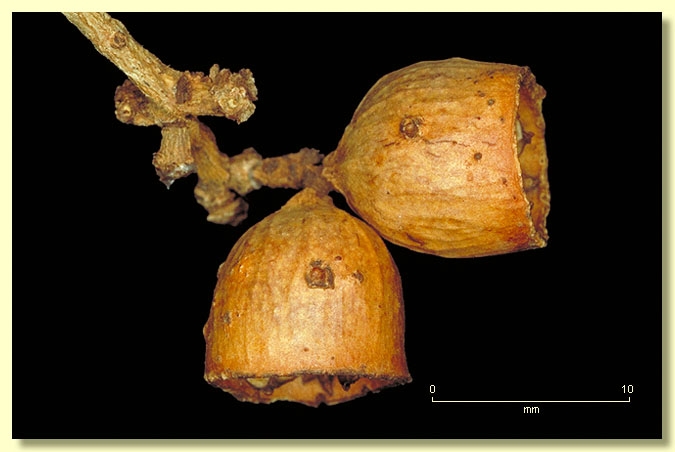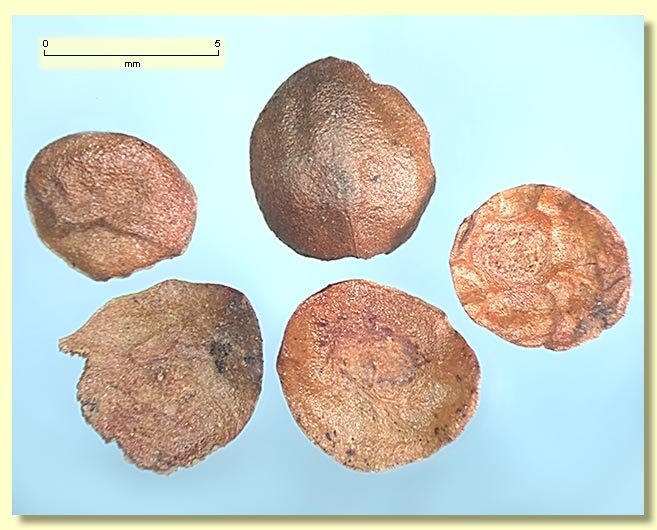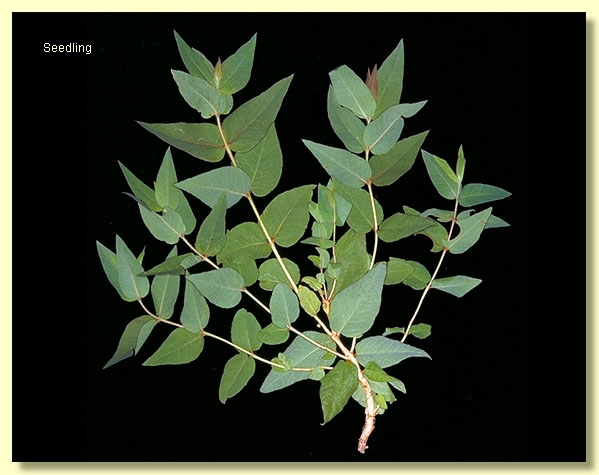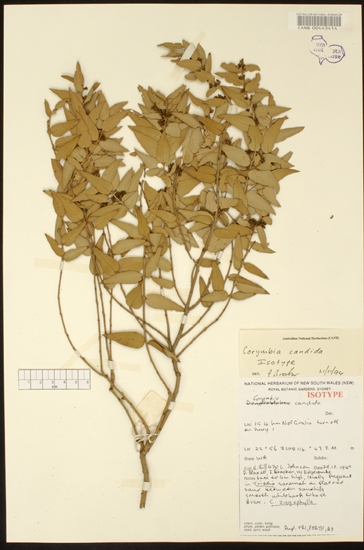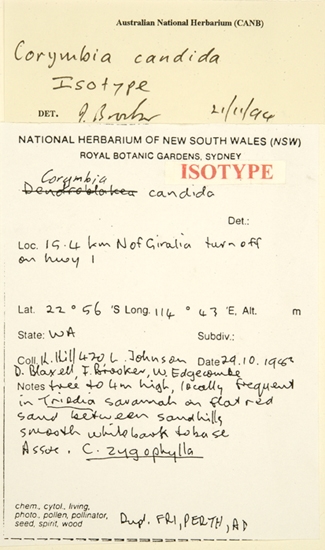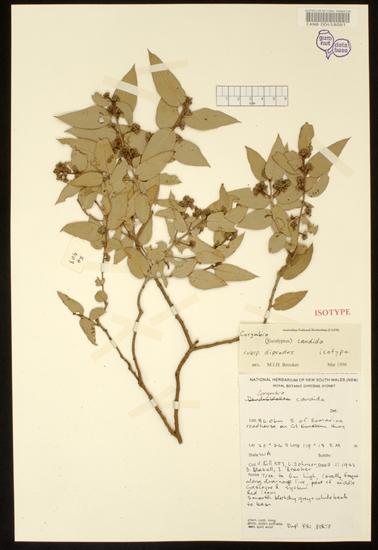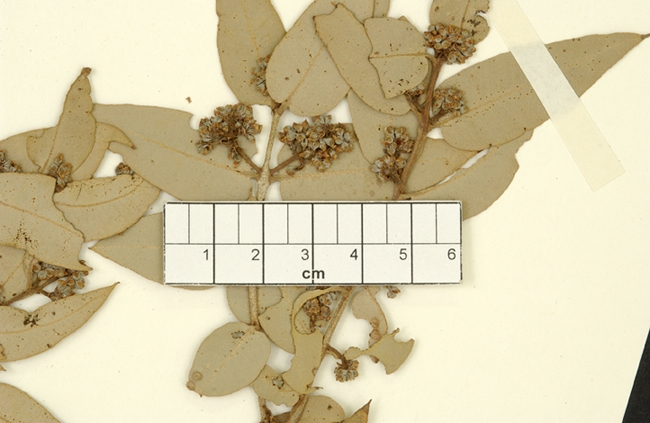Euclid - Online edition
Corymbia candida
Corymbia | Blakearia
Corymbia candida K.D.Hill & L.A.S.Johnson, Telopea 6: 440 (1995).
Tree to 10 m tall. Forming a lignotuber.
Bark smooth throughout, white or sometimes cream to very pale grey, powdery.
Branchlets lack oil glands in the pith; scabrid or ± smooth.
Juvenile growth (coppice or field seedlings to 50 cm): stems rounded in cross-section, setose with bristle-glands; juvenile leaves sessile, rarely with a petiole to 0.1 cm long, opposite, cordate, 2–4.5 cm long, 0.8–2.1 cm wide, amplexicaul, apex pointed, margin entire, greyish green, scabrid above and below.
Crown of juvenile opposite, sessile or with petioles to 0.4 cm long; blade cordate, rarely lanceolate, 3–8 cm long, 0.8–2.7 cm wide, base amplexicaul, margin entire, apex pointed, concolorous, dull, grey-green to pale green, usually scabrid but older leaves may be weathered to ± smooth, side-veins at more than 45° to midrib, reticulation very dense, intramarginal vein present, oil glands absent.
Inflorescence axillary compound, peduncles rounded to angular, 0.1–0.2 cm long, buds 3 per umbel, pedicels 0.1–0.9 cm long. Mature buds obovoid to pyriform (0.4–0.6 cm long, 0.4–0.5 cm wide), scar present (outer operculum shed during bud development), operculum flattened and very shallow, stamens usually inflexed rarely a few stamens irregularly flexed, all fertile, anthers oblong, dorsifixed, versatile, dehiscing by longitudinal slits, style long and straight, stigma ± tapering, locules 3, the placentae each with ovules not arranged in clear rows. Flowers white.
Fruit pedicellate (pedicels 0.2–0.9 cm long), cupular to cylindrical or barrel-shaped, 0.5–1.1 cm long, 0.6–1.1 cm wide, thin-walled, smooth, disc descending vertically, valves 3, enclosed.
Seeds brown to reddish brown, 3–6 mm long, flattened to saucer-shaped, dorsal surface smooth, hilum ventral.
Cultivated seedlings (measured at ca node 10): cotyledons large, orbicular to reniform; stems rounded in cross-section, setose with bristle-glands; leaves sessile or petiolate (petioles to 0.2 cm), opposite for 12+ nodes, cordate or ovate, 3.5–5.5 cm long, (1.3)1.8–3.3 cm wide, base amplexicaul, lobed or sometimes rounded by node 10, apex pointed, dull, green, concolorous or slightly discolorous, sparsely setose with bristle-glands on both sides.
Flowering has been recorded in July.
A small ghost gum tree occurring in groves distributed sporadically from the Exmouth Gulf hinterland and coastal lowlands north of there, the headwaters of the Gascoyne River, the Little Sandy Desert, the Great Sandy Desert and Gibson Desert of Western Australia, and extending into the Northern Territory in the Tanami Desert. It prefers low-lying sites of red-soil plains but in the upper Gascoyne and around Telfer and Marble Bar can occur on stony sites. It has a strikingly stark white trunk of powdery smooth bark and grey-green to pale green crown of almost smooth to scabrid, sessile to shortly petiolate opposite leaves on the branchlets.
Within the natural range of Corymbia candida the only smooth-barked, rough-leaved eucalypt likely to be confused is C. aspera, which has thinner-textured crown leaves with rounded (blunt) apex and fruit 0.4–0.7 cm diameter, whilst C. candida has thicker leaves with acute apex and fruit 0.6–1.1 cm diameter. In addition, C. aspera frequently has some persistent tessellated bark on the lower trunk, smooth bark with a pink-brown tinge and is found on sandstone and quartzite ridges and hills with its distribution generally being to the north and east of that of C. candida.
C. candida was originally described with three subspecies, viz. subsp. candida, subsp. dipsodes and subsp. lautifolia. Subsp. dipsodes, according to our field observations in the upper Gascoyne River and Little Sandy Desert area, is not consistently different from subsp. candida in those characters mentioned in the original description—adult leaf colour, scabridity and shape, and fruit size—and therefore is included in C. candida in EUCLID. Inland populations of C. candida do tend to be "more scabrid", whilst sub-coastal populations tend to have "smoother" leaves.
Subsp. lautifolia, according to our field observations, in the area between Port Hedland and Karratha, which includes the type locality, is highly variable in “adultness” of the crown leaves. Leaf characters such as leaves opposite or disjunct, scabrid or smooth, grey-green or yellow-green, sessile or shortly petiolate, size, and shapes from cordate to ovate and lanceolate, differ in adjacent trees. The ghost gums in these groves appear to be indeterminate in form and may reflect past hybridization of C. candida and another ghost gum, probably C. flavescens, a species with a more northerly distribution but with its most south-westerly occurrence near Port Hedland. C. candida subsp. lautifolia is regarded as a variable hybrid, not a distinct taxon, and is not included in EUCLID.
C. candida was split off from C. aspera by Hill & Johnson (1995). Another new species, C. punkapitiensis was named at this time (ibid., p. 449) from two specimens collected in the Rawlinson Ranges north of Giles, Western Australia, an arid area of restricted access. C. punkapitiensis shares the leaf apex shape of C. aspera and leaf thickness and slightly larger fruit of C. candida. Its habitat more closely resembles that of C. aspera than C. candida, being found on quartzite ridges. This species is so poorly known that it is at the moment not appropriate to include it in EUCLID.
Note added 2014: Dean Nicolle showed by repeated observations of the same trees in Central Australia that the name Corymbia punkapitiensis Hill & Johnson should be synonymous with Corymbia aparrerinja, the specimens coming from plants that had precociously flowered/fruited with a juvenile/intermediate leaved crown (see Nicolle, D. (2014), Nuytsia 24: 263-7). The trees he observed matured over the years to bear leaves indistinguishable from those of surrounding C. aparrerinja trees. Thus demonstrating the value of field work when dealing with trees.
MORE ABOUT CORYMBIA
MORE ABOUT GHOST GUMS
Corymbia candida: Latin candidus, glossy white, referring to the starkly white trunk.


